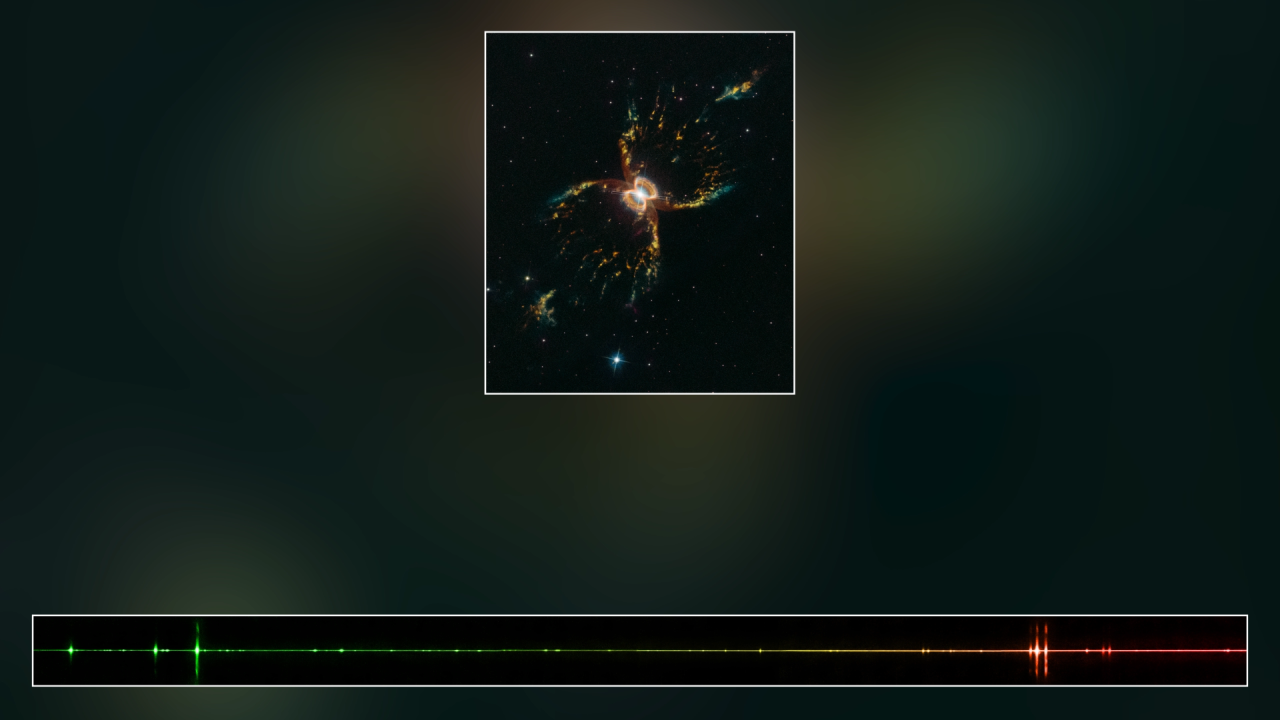1 min read
Southern Crab Nebula

In celebration of the 29th anniversary of the launch of NASA's Hubble Space Telescope, astronomers captured this festive, colorful look at the tentacled Southern Crab Nebula.
The nebula, officially known as Hen 2-104, is located several thousand light-years from Earth in the southern hemisphere constellation of Centaurus. It appears to have two nested hourglass-shaped structures that were sculpted by a whirling pair of stars in a binary system. The duo consists of an aging red giant star and a burned-out star, a white dwarf. The red giant is shedding its outer layers. Some of this ejected material is attracted by the gravity of the companion white dwarf.
The result is that both stars are embedded in a flat disk of gas stretching between them. This belt of material constricts the outflow of gas so that it only speeds away above and below the disk. The result is an hourglass-shaped nebula.
The bubbles of gas and dust appear brightest at the edges, giving the illusion of crab leg structures. These "legs" are likely to be the places where the outflow slams into surrounding interstellar gas and dust, or possibly material which was earlier lost by the red giant star.
The outflow may only last a few thousand years, a tiny fraction of the lifetime of the system. This means that the outer structure may be just thousands of years old, but the inner hourglass must be a more recent outflow event. The red giant will ultimately collapse to become a white dwarf. After that, the surviving pair of white dwarfs will illuminate a shell of gas called a planetary nebula.
The object was first reported in the late 1960s, but was assumed to be an ordinary star. In 1989, astronomers used the European Southern Observatory's La Silla Observatory in Chile to photograph a roughly crab-shaped extended nebula, formed by symmetrical bubbles.
These early observations only showed the outer hourglass emanating from a bright central region. Hubble photographed the Southern Crab in 1999 to reveal complicated nested structures. These latest images were taken in March 2019 with a wide set of color filters on Hubble's newest, sharpest detector, Wide Field Camera 3. This image is a composite of observations taken in various colors of light that correspond to the glowing gases in the nebula. Red is sulfur, green is hydrogen, orange is nitrogen, and blue is oxygen.
About the Object
- R.A. PositionR.A. PositionRight ascension – analogous to longitude – is one component of an object's position.14:11:52.09
- Dec. PositionDec. PositionDeclination – analogous to latitude – is one component of an object's position.-51:26:24.39
- ConstellationConstellationOne of 88 recognized regions of the celestial sphere in which the object appears.Centaurus
- DistanceDistanceThe physical distance from Earth to the astronomical object. Distances within our solar system are usually measured in Astronomical Units (AU). Distances between stars are usually measured in light-years. Interstellar distances can also be measured in parsecs.10,700 light-years
- DimensionsDimensionsThe physical size of the object or the apparent angle it subtends on the sky.Image is 1.4 arcmin across (about 4.4 light-years).
About the Data
- Data DescriptionData DescriptionProposal: A description of the observations, their scientific justification, and the links to the data available in the science archive.
Science Team: The astronomers who planned the observations and analyzed the data. "PI" refers to the Principal Investigator.The HST observations include those from program 15677 - InstrumentInstrumentThe science instrument used to produce the data.WFC3/UVIS
- Exposure DatesExposure DatesThe date(s) that the telescope made its observations and the total exposure time.11-14 March 2019
- FiltersFiltersThe camera filters that were used in the science observations.F475W, F502N, F606W, F656N, F658N, F673N
- Object NameObject NameA name or catalog number that astronomers use to identify an astronomical object.Southern Crab Nebula; He2-104
- Object DescriptionObject DescriptionThe type of astronomical object.Nebula with symbiotic Mira variable and white dwarf pair
- Release DateApril 18, 2019
- Science ReleaseHubble Celebrates 29th Anniversary with a Colorful Look at the Southern Crab Nebula
- Credit

These images are a composite of separate exposures acquired by the WFC3 instrument on the Hubble Space Telescope. Several filters were used to sample narrow wavelength ranges. The color results from assigning different hues (colors) to each monochromatic (grayscale) image associated with an individual filter. In this case, the assigned colors are: Blue: F502N Orange: F656N Green: F658N Red: F673N

Related Images & Videos

Compass Image for Southern Crab Nebula
Image of Southern Crab Nebula, with compass arrows, scale bar, and color key for reference. The north and east compass arrows show the orientation of the image on the sky. Note that the relationship between north and east on the sky (as seen from below) is flipped relative to...

Colors of the Southern Crab Nebula
Dissecting the Southern Crab Nebula This diagram illustrates how Hubble Space Telescope spectral observations were used to study the chemical makeup of the Southern Crab Nebula. The hourglass-shaped nebula contains elements forged in the interior of its two aging central stars...

Shape of the Southern Crab Nebula
Diagram of the Southern Crab Nebula Structure This diagram traces the hourglass structure formed by a pair of huge, bipolar gas bubbles ejected by a double star in the center of the Southern Crab Nebula. The gases are dispersed too thinly for the full shape of the hourglass to...

Spectroscopy Animation of Southern Crab Nebula
Dissecting the Southern Crab Nebula This video illustrates how Hubble Space Telescope spectral observations were used to study the chemical makeup of the Southern Crab Nebula. The hourglass-shaped nebula contains elements forged in the interior of its two aging central stars...
Share
Details
Claire Andreoli
NASA’s Goddard Space Flight Center
Greenbelt, Maryland
claire.andreoli@nasa.gov































